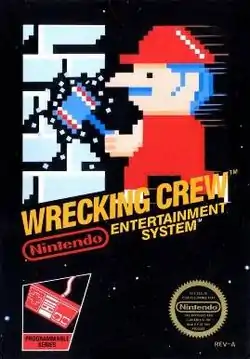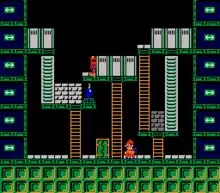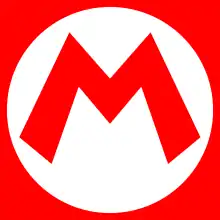Wrecking Crew (video game)
Wrecking Crew[lower-alpha 1] is a 1985 action game developed and published by Nintendo. It was designed by Yoshio Sakamoto and released as a launch title for the Nintendo Entertainment System.
| Wrecking Crew | |
|---|---|
 REV-A boxart | |
| Developer(s) | Nintendo R&D1[1] |
| Publisher(s) | Nintendo |
| Designer(s) | Yoshio Sakamoto |
| Artist(s) | Yoshio Sakamoto |
| Composer(s) | Hirokazu Tanaka |
| Series | Mario |
| Platform(s) |
|
| Release | |
| Genre(s) | Action, Puzzle |
| Mode(s) | Single-player, multiplayer |
Gameplay

The player controls Mario (or Luigi in two-player mode) and attempts to destroy all of a certain set of objects with a large hammer on each of 100 levels. Mario cannot jump because of the hammer's weight. The player can select any level to start on from the title screen. Each level takes place on a playfield divided into an invisible grid, each space of which can contain one object. Objects include destructible walls, pillars, and ladders, indestructible barrels and ladders, bombs that destroy all connected destructible objects, and various enemies that Mario must avoid. Doors may also exist, which can be opened to cause enemies to move harmlessly into the background. The game also introduced a new character, a construction foreman named Spike, who chases Mario and attempts to disrupt him by knocking down objects and causing him to fall to the bottom of the playfield. The player starts the game with five lives and loses a life whenever Mario comes in contact with an enemy or fireball. The game is over when all lives are lost. The game can also be aborted at any time, and must be aborted if Mario becomes trapped in a barrel.
Because Mario lacks the ability to jump, the player must figure out the optimal order in which to destroy objects—for example, if a player destroys a ladder too soon, a wall may become unreachable and thus the player cannot finish the level. Destroying multiple objects in a row (usually with a chain of bombs) scores extra bonus points, and occasionally bonus items may appear that Mario can collect.
Wrecking Crew also features a level editor, which allows the player to design up to four custom levels that can be saved and loaded using the Famicom Data Recorder, a peripheral for the Famicom used to store and reload data from games to a cassette tape. Due to the fact that this peripheral was only released in Japan, the ability to save and load custom levels was rendered useless in other territories outside of Japan. The game's U.S. manual includes a note stating that the load and save functions "have been programmed in for potential product developments". The feature was later reenabled for the game's Wii Virtual Console release using Wii system storage.
Development
Wrecking Crew was designed by Yoshio Sakamoto.[4] Hirokazu Tanaka composed the game's music.[5]
Audio
A piece of music was remixed for use in the Nintendo GameCube video game Dance Dance Revolution: Mario Mix. The "Golden Hammer" music from Wrecking Crew was later used in the Wii video game Super Smash Bros. Brawl and plays every time a fighter grabs a Golden Hammer, or on the "Mario Bros." stage. There are also two pieces of music used in Super Smash Bros. For Wii U; one that is a medley of the game's soundtrack, and a remix medley, both of which appear on the Wrecking Crew Stage. Similar to Smash Bros. Brawl, the Switch game Super Smash Bros. Ultimate also plays the Golden Hammer music when a fighter grabs a hammer.
Re-releases
In 1984, Nintendo released an arcade version of this game, titled Vs. Wrecking Crew, adding a simultaneous two-player mode.[6]
Wrecking Crew was re-released in 1989 on the Family Computer Disk System, and was later included as the 14th title of the Famicom Mini series on Game Boy Advance in 2004.[7]
The game has been re-released on Virtual Console three times: on Wii in 2007, on Nintendo 3DS in September 2011 as part of the "Ambassador Program",[8][9] on the 3DS eShop in Japan, North America, and Europe and Australia in September 2012, March 2013, and May 2013 respectively. Wrecking Crew was also released on the Virtual Console for the Wii U system on June 19, 2013 in Japan and on June 20, 2013 in North America and Europe. All Virtual Console versions (except for the 3DS VC version) support saving levels designs, which is not possible in the original NES version of the game.
Reception
In Japan, Game Machine listed VS. Wrecking Crew on their October 1, 1984 issue as being the thirteenth most-successful table arcade unit of the year.[10]
Sequel
| Wrecking Crew '98 | |
|---|---|
| Developer(s) | Nintendo R&D1, Pax Softnica |
| Publisher(s) | Nintendo |
| Designer(s) | Yoshio Sakamoto |
| Composer(s) | Hirokazu Tanaka |
| Series | Mario |
| Platform(s) | Super Famicom |
| Release | Nintendo Power (SFC)[11]
|
| Genre(s) | action puzzle game |
| Mode(s) | Single-player, multiplayer |
Wrecking Crew '98[lower-alpha 2] is an action puzzle game released exclusively in Japan in 1998 for the Super Famicom's Nintendo Power download game service and later for the Super Famicom itself. The game is a sequel to the original, which is included as a bonus in the game. Unlike the original, in which the player's objective was to find ways to clear each level of all panels, Wrecking Crew '98 takes a more competitive approach, where two opponents are given their own sides to clean up. Each player must try to demolish as many panels as they can on their side, until the opponent's side is completely piled up, to win.
The game's story mode features Mario returning to the Mushroom Kingdom from a trip, then discovering that Bowser has started a construction campaign of building new hideouts. The construction is depriving the flora of sunlight and thus, Mario decides to demolish the new construction sites with his hammer. Along the way, he meets his old enemies from the original Wrecking Crew, including former rival Foreman Spike.
- Story mode: The main single player mode, where one controls Mario and travels through an overworld, entering each of Koopa's construction sites.
- Versus mode: A competitive mode where one can compete with a friend or the CPU. The player can choose between Mario or characters that are unlocked from Story Mode.
- Tournament mode: Available after the player has cleared the main game once. Eight characters compete in a single-elimination tournament until only one remains and is declared the champion.
See also
Notes
References
- やればやるほどディスクシステムインタビュー(前編). Nintendo Dream (in Japanese). Mainichi Communications Inc. (118): 96–103. August 6, 2004.
- Kohler, Chris (October 18, 2010). "October 18, 1985: Nintendo Entertainment System Launches". Wired.
- "Wrecking Crew". NinDB. Retrieved October 27, 2011.
- Chris Kohler (April 7, 2010). "Q&A: Metroid Creator's Early 8-Bit Days at Nintendo". Wired: GameLife. Condé Nast Digital. Retrieved August 26, 2010.
- Famicom 20th Anniversary Original Sound Tracks Vol. 1 (Media notes). Scitron Digital Contents Inc. 2004.
- "Vs. Wrecking Crew". iBomb. Retrieved October 27, 2011.
- Giffords, Kevin (January 1, 2000). "Wrecking Crew (Famicom Mini 14)". 1up.com. Archived from the original on July 16, 2012.
- Thomas, Lucas M.: "Nintendo 3DS Ambassadors, Behold Your Final Five NES Rewards - DS Feature at IGN" August 30, 2011
- Luke. "3DS Ambassador Games Impressions - Super Balloon Wrecking Bros". ForkThisLlama. Retrieved September 7, 2011.
- "Game Machine's Best Hit Games 25 - テーブル型TVゲーム機 (Table Videos)". Game Machine (in Japanese). No. 245. Amusement Press. 1 October 1984. p. 35.
- "Wrecking Crew '98". NinDB. Retrieved October 27, 2011.
